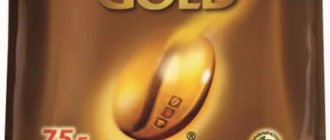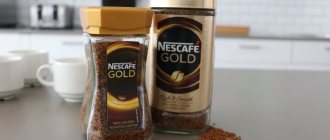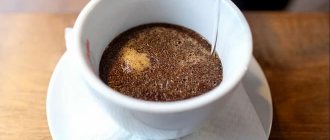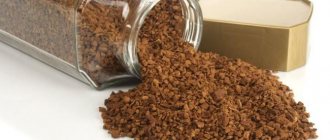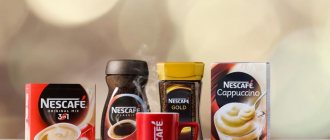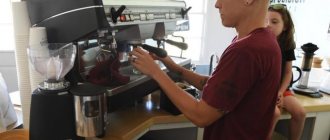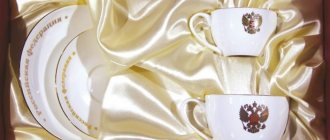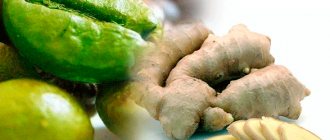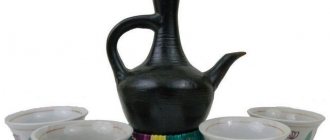The Nescafe brand has gained immense popularity around the world. It began its existence in Switzerland in 1938, but back in 1930 it sent a request to Brazilian plantations asking them to come up with a way to preserve the taste and aroma of grains for a long time. This is how the technology for making instant coffee was invented.
Currently, Nescafe offers a wide selection of instant drinks. Gourmets especially appreciate Nescafe GOLD Barista, which delights with an unrivaled combination of ground and instant coffee. A mix of light and dark roasted beans will give you an indescribable feeling of vivacity, energy, and will delight you with a great taste and aroma.
A few words about the brand
Nescafe instant coffee was first released in Switzerland in 1938. Coffee lovers immediately appreciated the new product and were happy to purchase the instant drink. But the Second World War began. Members of the American Army began to regularly consume Nescafe, which was easy to prepare and filled tired bodies with vitality. After the end of the war, the popularity of Nescafe rapidly gained momentum. Now in all countries of the world you can meet many fans of the instant drink.
What kind of coffee is Nescafe Barista?
The combination of instant coffee and ground Arabica coffee creates a delicious aroma and pleasant taste. Finely ground grains are placed into the particles of soluble granules. When brewed, the mix opens up and creates an amazing coffee blend.
Any barista will confirm that the combination of several types of beans fully reveals the coffee aroma and taste. Using unique technologies, Nescafe Barista combines dark and light roasted Arabica beans. Hand-picked grains are used as raw materials. They are fried to the desired color, and then ultra-finely ground Arabica is added.
Light roasted beans give a soft, velvety taste, while dark roasted beans give the drink strength and charge you with energy for the whole day.
Instant coffee
Instant coffee is incredibly popular in Russia and accounts for 80% of the coffee market. If you last tried instant coffee many years ago, try it today - technology does not stand still and now you can preserve the taste and aroma of a natural drink to the maximum in an instant version. Our assortment includes modern brands of granulated and freeze-dried instant coffee that help you keep up with the times. They have a number of undoubted advantages. Advantages and benefits of instant coffee:
- speed of preparation and guaranteed results;
- the price per serving is lower;
- the semi-finished product is stored longer than whole or ground coffee beans;
- the concentrated version is convenient to transport and store in a minimum space;
- does not require special utensils, extra. recycling mechanisms, minimum waste.
- Convenient mixing for preparing coffee-based drinks and cocktails.
The first mentions of instant coffee appeared at the turn of the 19th and 20th centuries. Mass production and sales were established in 1906–1909. And for more than a century, manufacturers have been perfecting the process of making coffee, which is prepared instantly, only by adding water and without additional equipment. Initially, instant coffee took the form of a dried powder obtained from concentrated coffee raw materials brewed in the usual way. This type of coffee is still included in vending mixtures: when all the ingredients are powdered, it gives the best brewing result. This is the most budget-friendly and profitable option for instant coffee for business. The soluble powder obtained by drying the coffee drink was replaced by agglomerations of dried coffee - granulated coffee. In this form, it is easier for the coffee product to retain its properties from absorbing moisture and caking. The next step in an attempt to preserve the original taste and aroma of coffee was vacuum drying by freezing freshly brewed coffee extract. Today this is the most perfect instant coffee - sublimated, freeze-dried. Freeze-dried coffee is usually light brown with a reddish tint and is sold for individual consumption, in glass or in ziplock bags. The desire to obtain a more natural and aromatic drink led to the emergence of the “ground coffee in instant” format. Ground coffee is added in small quantities to maintain the benefits of instant coffee: fast preparation and no sediment.
Of particular interest in the category of quick drinks are packaged 3-in-1 coffee mixes with sugar and cream. This is a palette of tastes and aromas with the same accessibility: you just need to add water and stir.
If you don’t have time and special utensils for brewing coffee, use the products of leading coffee brands in the Barista-ltd online store: • Alma Food; • Coffesso • Ristora; • De Marco; • Aristocrat; • ICS; • Jockey, including 3 in 1; • Jardin; • Nescafe (world leader); • Black Card (Russian leader).
In our online store we have a large assortment of instant coffee presented and constantly updated at the best price. Free delivery is possible in Moscow, delivery to the Transport company of your choice. The entire network of Boxberry points (Moscow and regions) is also available for you. Free pickup - six days a week at the address: Shosse Entuziastov, 56, building 24 (territory)
Price
The cost of Nescafe Barista coffee depends on the packaging, the importer, the pricing policy of specific retail chains, etc. In order not to purchase a counterfeit, it is advisable to buy the drink in large hypermarkets or trusted online stores, where you will be provided, if necessary, with all the documents confirming the authenticity of the product .
Average cost of instant freeze-dried coffee "Nescafe GOLD Barista" depending on the weight of the package:
- 75 g – 135-140 rubles;
- 85 g – 310-320 rub.;
- 120 g – 235-245 rubles;
- 400 g (in a bag) – 1100 rub.
Cooking method
To enjoy the deep, rich taste and aroma, you don’t have to go to a coffee shop or spend time making espresso at home. Just pour a few teaspoons of Nescafe GOLD Barista into a cup and add hot water (not boiling water!). Mix thoroughly and you are ready to begin your morning ritual. And at lunch, a cup of an invigorating drink will fill you with energy, charge you with positivity and give you the opportunity to effectively work through the rest of the evening.
You can add milk, cream, sugar, honey, syrup or any other ingredient of your choice to the drink.
History of Nescafe coffee
Initially, Nestle was engaged in the production of only baby food and condensed milk. But in 1929, the president of the company, Louis Dapplet, received an interesting offer. Due to the global financial crisis, coffee sales in Brazil fell catastrophically and a huge amount of unsold beans accumulated in warehouses. Meanwhile, a new harvest was ripening, and the accumulated beans were in danger of spoiling.
Several of these stocked warehouses belonged to the bank with which the Nestle concern had financial affairs. And the financiers offered the company an experimental task: to create a new coffee product that could be stored for a long time. German chemist Max Morgenthaler was invited to solve the problem. We should thank him for the idea of producing instant coffee, which can be prepared by simply pouring hot water over the powder.
Research and development took about four years. The first results were unsatisfactory: the resulting product did not meet the requirements either in terms of taste or aroma. And the powder did not dissolve well. There were attempts to immediately add sugar and freeze-dried milk, but this route also led to a fiasco.
It was only in 1937 - eight years after the start of work - that instant coffee was produced and evaluated by Nestle management. A year later, the new product was presented to customers. They released it under the Nescafe brand, combining the first part of the Nestle company name and the word cafe (“coffee”).
Instant coffee did not immediately gain popularity. But then World War II broke out, and the ability to quickly brew an invigorating drink right in a cup was finally appreciated.
Attention!
Most of the instant coffee produced by Nescafe in the late 1930s and early 1940s went to the US Army.
In 1952, Nescafe chemists made a new discovery that made it possible to produce instant powder from natural coffee beans, using virtually no artificial additives. The taste of the drink has undergone significant changes - of an exclusively positive nature. Since then, the drink has actively spread throughout the world.
Beginning in the 60s of the 20th century, flavorings began to be added to the drink. Soon granulated coffee was invented. Every year the company releases new types that can satisfy the most demanding tastes.
Reviews
Maria, St. Petersburg:
I only drink instant coffee. I used to buy Egoist coffee, but now the price has risen significantly, and I decided to try something more affordable. First I bought Jacobs Millicano, but I wasn’t very pleased with the taste. Next in line was Nescafe Barista. I was immediately captivated by the design of the jar. As always, impeccable, stylish, catchy. When I brewed it in a cup, a coffee aroma appeared, but the granules dissolved slowly, so you have to actively stir the contents with a spoon. The taste pleased me: soft, delicate, and at the same time strong. Now I have jars of Nescafe Barista at home and at work. A great option to quickly wake up in the morning when there is no time to rock. At lunchtime at work I always brew a cup of Nescafe. Sometimes I add cream or milk, but in its pure form the drink is very good.
Olga, Samara:
My morning always starts with a cup of coffee. This is a long-term ritual that I never break. I like to froth milk in a French press, it takes a couple of minutes, but the drink with airy foam turns out incomparable. I always buy Nescafe - a proven brand that I trust. The new Nescafe Barista is no exception: the taste is coffee, rich, and the aroma is pleasant.
Pavel, Kungur:
I can drink both ground and instant coffee. Sometimes there is no time to brew coffee, so your favorite Nescafe comes to the rescue. I have tried many different brands, but Nescafe occupies a leading position in my ranking. I buy Nescafe Barista in zip-lock packaging. The package is convenient to take with you to the office or to the country. Granules without dust and foreign impurities. When you brew coffee, there is no smell of burnt beans, as often happens with low-quality sublimate. The taste is pleasant, invigorating, no “chemistry” is felt. I didn’t find any downsides to Nescafe Barista, so I can confidently recommend it to all instant coffee lovers.
The best instant coffee. Test results
Instant coffee is perhaps one of the most popular office drinks, and when you need to cheer up from the autumn blues, it has no price at all. The most important thing is to choose the right coffee.
By the way, the product itself is just over a hundred years old - at the beginning of the last century its industrial production began in the USA. And instant coffee passed its main test of suitability not in offices, but in the trenches of the First World War.
Uralweb natural scientists decided not to bring the situation to hostilities, and therefore we conducted a simple and understandable test of the most popular brands of instant coffee.
In general, instant coffee comes in three types. The first type is powder. It is the cheapest to produce, but very poorly retains the taste of natural coffee. The second type is granular. Special solutions are used for its production; as a result, it retains its taste better, but is also more expensive. But the most expensive to produce is freeze-dried or frozen coffee.
This method is considered the best, since its use better preserves the taste of coffee and nutrients. The coffee extract is frozen, then the ice is crushed, and the moisture is removed from it by sublimation. They believe that this type of coffee tastes better, and this is the kind of coffee we decided to test. All products were in equal conditions: one teaspoon was mixed with a glass of hot and cold water. In the second case, we found out the solubility of coffee. The fact is that according to GOST, freeze-dried coffee must completely dissolve in cold water without sediment in 3 minutes.
Moccona coffee is the first participant in today's test. At the same time, it is also one of the most expensive. 100 g of product cost us 273.8 rubles. , Mytishchi.
Externally, the coffee looks very solid - large “pebbles” of a darkish color. The impression is that this is dark roast coffee. That is, more bitter and strong. There is no indication of the type of coffee on the packaging. After brewing, the coffee does not have a very distinctive coffee aroma. The taste is completely empty. There is only a slight hint of coffee in it. In cold water, the coffee dissolved completely in less than a minute. In the end, Moccona received a total of 37 points .
The next participant is the cool Bushido . It’s cool not only because it’s Japanese, but it’s also the most expensive. Although in fact it is not Japanese, but Swiss. Manufacturer: HACO Ltd. 100 g of product costs 415 rubles.
The size of the coffee granules is quite large, although smaller than Moccona. At the same time, the can indicates that the composition of the coffee is 100% Arabica. Whether this is true or not, we cannot say.
The aroma is quite “coffee”, and the taste is very strong and even bitter. The roast is very dark, so the coffee is more suitable for those who like a stronger taste. As a result, opinions were divided, and lovers of a milder taste of coffee “downvoted”. In addition, the “cold test” was failed - even after 3 minutes the coffee did not completely dissolve. The result is 38 points .
Third coffee – Jacobs Monarch , . 100 g of this coffee cost us 221 rubles. Instead of indicating the types of coffee and other important information on the can, only poetic lines were found about how wonderful it is to brew a cup of such coffee.
So, there is nothing miraculous about this. Brewed coffee has a very faint odor and no taste at all. There is simply nothing to try. The coffee dissolved in cold water for almost three minutes, but still met the standard with a squeak. 34 points.
Jardin coffee is perhaps the most “budget” participant in the test. Only 156 rubles per 100 g of product. , Leningrad region. There are no complaints about the appearance - smooth and large “pebbles”. Again, there is no indication of the type of coffee.
As for the aroma, it seems somehow sour, and the taste is the same. The acidity is felt quite clearly, and the actual coffee taste is very weak. The “cold test” was passed in 1 minute, that is, it dissolves well. The result is 36 points.
We reached the giants - Nescafe Gold . , Krasnodar region. The cost of 100 g of coffee is 222 rubles. What Nescafe has done a good job on is the aroma. Both dry coffee and brewed coffee smell the same as coffee, although the type of coffee is not indicated anywhere.
As for the taste, it is clearly inferior in strength to the aroma. The taste is rather weak and inexpressive. There is only a slight coffee bitterness. The “cold test” was completed in 2 minutes. The result is 38 points . The result is not bad.
The sixth participant is MacCoffee , Moscow region. The cost of 100 g of product is 153 rubles, this is the lowest price among all participants in the audit. Nevertheless, the manufacturer promised for this money no less than “Standard of Taste.”
We don’t know what flavor was planned to be used as a standard, but it’s definitely not the taste of coffee. Dry coffee had a very strong smell, but when brewed there was no smell at all. At the same time, the taste was quite sharp and bitter. It never dissolved in cold water. In general, it’s very “not for everybody.” By the way, there were no such lovers among us, so only 29 points .
Next coffee is Tchibo . By the way, we buy this for our office. It’s difficult to find any objective reasons, it just happened that way. So, 100 g of this coffee costs 190 rubles - the price is quite low. , Moscow region.
The aroma of coffee is quite pleasant, but the taste is not very expressive and slightly sour. It’s difficult to say anything special about him. The “cold test” was also not impressive - the coffee took 3 minutes to dissolve in cold water. The final score is 34 points .
Black Card coffee is one of the few brands that is 100% Arabica coffee. We can confirm this, however, only with the inscription on the can. , Nizhny Novgorod. The cost is 186 rubles per 100 g, one of the lowest among all products.
The coffee doesn’t look very confident: the “pebbles” crumble and a lot of coffee dust forms inside. The smell of coffee is very pungent and smells like something burnt. As for the taste, it seems empty, at least it does not have a pronounced coffee bitterness. It also dissolves quite slowly in water. It took two and a half minutes to completely dissolve in cold water. Score – 35 points .
And our latest participant is Carte Noire produced by Kraft Foods LLC, Germany. In terms of cost, this coffee was in second place, almost falling short of Bushido - 346 rubles per 100 grams.
However, Carte Noire stood out in both taste and aroma. In general, both turned out to be, if not ideal, then perfectly balanced. The aroma is purely coffee, without any foreign impurities, the taste is moderately tart. The “cold test” was passed in less than a minute, which means it dissolves perfectly. The final result is 52 points .
And here are our results:
1. Carte Noire is declared the winner.
2. Bushido, Nescafe and Moccona also looked good.
3. Moccona and Carte Noire dissolve best in water. The worst ones are Bushido and MacCoffee.
4. The most expensive coffee is Bushido, the cheapest is MacCoffee.
| Brand, manufacturer | Cost per 100 g. | Place/Rating | |
| 1. | Black card, Grand-NN LLC, Nizhny Novgorod | 186.20 rub. | 5th place/35 points |
| 2. | Carte Noire, Kraft Foods, Germany | RUR 346.20 | 1st place/52 points |
| 3. | Jardin, Orimi Trade LLC, Leningrad region. | RUB 156.42 | 4th place/36 points |
| 4. | Jacobs, Kraft Foods Rus LLC, Leningrad region. | 221.27 rub. | 6th place/34 points |
| 5. | Bushido, HACO Ltd, Switzerland | RUR 415.80 | 2nd place/38 points |
| 6. | Nescafe, Nestle Kuban LLC, Krasnodar region | RUR 222.36 | 2nd place/38 points |
| 7. | MacCoffee, Seda International LLC, Moscow region. | 153.90 rub. | 7th place/29 points |
| 8. | Moccona, Intercafe LLC, Mytishchi | 273.80 rub. | 3rd place/37 points |
| 9. | Tchibo, Chibo CIS LLC, Moscow region. | 189.50 rub. | 6th place/34 points |
If you don’t take instant coffee seriously, but like to drink good freshly brewed coffee in a coffee shop, find out where cappuccino tastes better, where you can drink coffee at 6 am and where you should invite your foreign guests, as well as how much it will cost, in our article Tested on... coffee.
